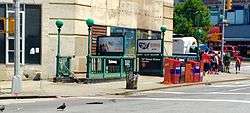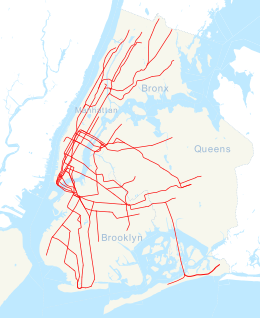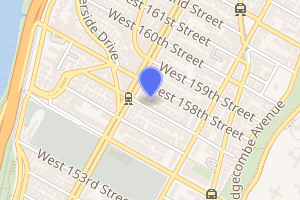157th Street station
157th Street is a local station on the IRT Broadway–Seventh Avenue Line of the New York City Subway. Located at the intersection of Broadway and 157th Street in Washington Heights, Manhattan, it is served by the 1 train at all times.
157 Street | |||||||
|---|---|---|---|---|---|---|---|
242nd Street-bound platform looking south | |||||||
| Station statistics | |||||||
| Address | West 157th Street & Broadway New York, NY 10032 | ||||||
| Borough | Manhattan | ||||||
| Locale | Washington Heights | ||||||
| Coordinates | 40.834°N 73.944°W | ||||||
| Division | A (IRT) | ||||||
| Line | IRT Broadway–Seventh Avenue Line | ||||||
| Services | 1 | ||||||
| Transit connections | |||||||
| Structure | Underground | ||||||
| Platforms | 2 side platforms | ||||||
| Tracks | 2 | ||||||
| Other information | |||||||
| Opened | November 12, 1904 | ||||||
| Station code | 303[1] | ||||||
| Wireless service | |||||||
| Opposite-direction transfer available | No | ||||||
| Traffic | |||||||
| Passengers (2019) | 3,739,786[3] | ||||||
| Rank | 134 out of 424[3] | ||||||
| Station succession | |||||||
| Next north | 168th Street: 1 | ||||||
| Next south | 145th Street (local): 1 96th Street (express): no regular service | ||||||
| |||||||
| |||||||
| |||||||
History
Opening
157th Street was first opened on a temporary basis on October 29, 1904, at which point it was still incomplete.[4] The station was used to allow passengers to get fans to a football game heading to the Yale–Columbia football game at the Polo Grounds.[5] At the time, the original northern terminal of the original IRT was 145th Street, the next station south.[6][7]
157th Street was formally opened on November 12, 1904. This station was the first to be added to the subway following the opening of the original 28 stations. The station's opening was delayed by two weeks because there was still painting and plastering work going on in the station.[8] 157th Street thus became the terminal for trains not going via the IRT Lenox Avenue Line. The terminal of 157th Street had facilities for switching trains, relieving congestion at 96th Street. On March 12, 1906, the IRT was extended from 157th Street to 221st Street.[9] Shuttle trains served the new extension terminating at 157th Street, meaning that passengers south of 157th Street wanting to go to stations on the extension had to transfer at 157th Street.[10] On May 30, 1906, express trains began running through to 221st Street, eliminating the need to transfer at this station.[11]
Platform extensions
In 1948, platforms on the IRT Broadway–Seventh Avenue Line from 103rd Street to 238th Street were lengthened to 514 feet (157 m) to allow full ten-car express trains to stop at this station. Previously, the station could only hold six-car local trains. The platform extensions were opened in stages. On April 6, 1948, the platform extension opened for stations from 103rd Street to Dyckman Street, with the exception of 125th Street.[12][13]
Station layout
| G | Street level | Entrance/exit |
| P Platform level |
Side platform | |
| Northbound | ← | |
| Southbound | (No service: 96th Street) | |
| Side platform | ||
This station has two tracks and two side platforms,[14] which are narrow, even by IRT standards. The platforms contain their original trim line that includes "157" mosaics and name tablets reading "157TH ST." There are also directional signs on the tiles containing white lettering on a black background and brown border.[15] Both platforms have tiled columns that run along the entire length and contain "157" painted in black.[16] Some of the columns separating the two tracks have "157" signs in black letting on white borders.[17]

Exits
Each platform has one same-level fare control area near the middle. Both are fully staffed, containing a turnstile bank and token booth, and each has two street stairs. The northbound side's two exits lead to the southeast corner of 157th Street and Broadway, and the southbound side's two exits lead to the northwest corner of the intersection. There are no crossovers or crossunders to allow free transfers between directions. Only the South Ferry-bound side token booth is staffed.[18]
References
- "Station Developers' Information". Metropolitan Transportation Authority. Retrieved June 13, 2017.
- "NYC Subway Wireless – Active Stations". Transit Wireless Wifi. Retrieved November 13, 2019.
- "Facts and Figures: Annual Subway Ridership 2014–2019". Metropolitan Transportation Authority. 2020. Retrieved May 26, 2020.
- Cudahy, Brian J. (1995). Under the Sidewalks of New York: The Story of the Greatest Subway System in the World. Fordham Univ Press. ISBN 9780823216185.
- "Subway On East Side Will Be Opened Soon: New Switching Station on West Side Nearly ready, too - Football Trains On Today" (PDF). The New York Times. November 12, 1904. p. 16. Retrieved 19 August 2015.
- James Blaine Walker, Fifty Years of Rapid Transit, 1864-1917, published 1918, pp. 162-191
- "On this day - New York City subway opens". History Channel. A&E Television Networks. November 6, 2019. Archived from the original on February 8, 2020. Retrieved 30 March 2020.
- Real Estate Record and Builders' Guide. F. W. Dodge Corporation. 1904.
- "Farthest North in Town by the Interborough" (PDF). The New York Times. January 14, 1907. p. 18.
- Interborough Rapid Transit Company (1906). Subway Division - New York City (Map).
- "Express to 221st Street: Will Run In the Subway To-day–New 181st Street Station Ready" (PDF). The New York Times. May 30, 1906. p. 1.
- Report for the three and one-half years ending June 30, 1949. New York City Board of Transportation. 1949. hdl:2027/mdp.39015023094926.
- "More Long Platforms – Five Subway Stations on IRT to Accommodate 10-Car Trains" (PDF). The New York Times. July 10, 1948. p. 8. ISSN 0362-4331. Retrieved March 27, 2016.
- Dougherty, Peter (2006) [2002]. Tracks of the New York City Subway 2006 (3rd ed.). Dougherty. OCLC 49777633 – via Google Books.
- Cox, Jeremiah (June 24, 2008). "A 157th Street name tablet in the extension portion of the station, a very IND era exit sign with an arrow for the only exit to 157th St is underneath it". subwaynut.com. Retrieved August 26, 2019.
- Cox, Jeremiah (June 24, 2008). "Tiled columns that are extremely frequent line the platform at 157 Street". subwaynut.com. Retrieved August 26, 2019.
- Cox, Jeremiah (June 24, 2008). "157 signs on the columns between the two tracks there". subwaynut.com. Retrieved August 26, 2019.
- "MTA Neighborhood Maps: Harlem / Hamilton Heights" (PDF). mta.info. Metropolitan Transportation Authority. 2018. Retrieved October 1, 2018.
External links
| Wikimedia Commons has media related to 157th Street (IRT Broadway – Seventh Avenue Line). |
- nycsubway.org – IRT West Side Line: 157th Street
- Station Reporter – 1 Train
- The Subway Nut – 157th Street Pictures
- 157th Street downtown entrance from Google Maps Street View
- 157th Street uptown entrance from Google Maps Street View
- Platforms from Google Maps Street View



